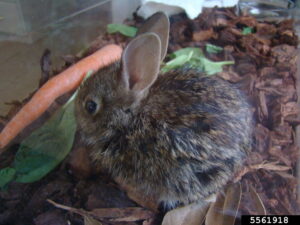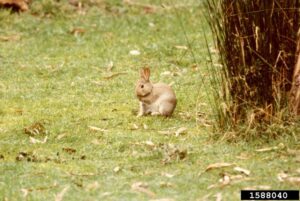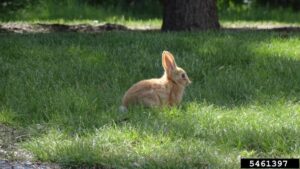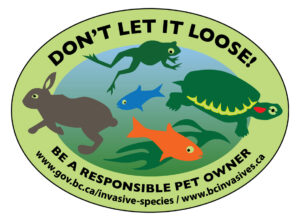EUROPEAN RABBITS (Oryctolagus cuniculus) and EASTERN COTTONTAIL RABBITS (Sylvilagus floridanus)
FOUND IN B.C.? Yes.
European rabbits are found on: Vancouver Island, Triangle Island, along the Southern Coast, and in the Okanagan.
Eastern Cottontail found in: the Fraser Valley, Vancouver area, and on Vancouver Island.
Identification

Domestic European Rabbit. Photo credit: Rebekah D. Wallace, University of Georgia, Bugwood.org
European
European rabbits that are present in BC are descended from domestic rabbits, so appear to look just like the ones sold in pet stores. They vary in colour, and can be brown, black, white, or a combination of these colours. These rabbits typically have a beige ring around their eyes, and are 38-50 centimetres long.

Adult Eastern Cottontail. Photo credit: Caleb Slemmons, National Ecological Observatory Network, Bugwood.org
Eastern Cottontail
Eastern Cottontail rabbits are smaller than European rabbits, and are typically about 44 centimetres long. They have grey-brown fur, with a distinctive rusty red colour on the back of their head. They have small, fluffy brown tails that are white underneath, and long ears that have black tips.
Life Cycle
Once introduced to an area, both species of rabbits are capable of rapidly reproducing. European rabbits can have 18-30 young in one year, and Eastern cottontail rabbits have 3-4 litters in their lifetime, with up to 8 offspring in each litter. These rabbits reach sexual maturity very quickly (within 2-3 months) and populations rapidly expand. European rabbits live up to 10 years in captivity, while Eastern Cottontails live for about 1-3 years.

A juvenile Eastern Cottontail. Photo credit: Rebekah D. Wallace, University of Georgia, Bugwood.org.
Ecology
European
These rabbits are herbivores that eat a wide variety of vegetation, which allows them to adapt to many different areas and food sources. They can then out compete native species for food and habitat. European rabbits build burrows underground, called warrens, which lead to increased soil erosion. Their favourite habitats include fields, forests, meadows, crop fields, and roadsides. In Southern BC, these types of habitats are especially suited to these rabbits as winters are mild and food can be sourced year round.

Feral European rabbit. Photo credit: Alfred Viola, Northeastern University, Bugwood.org
Eastern Cottontail
Cottontail rabbits are also generalized herbivores that will eat a wide range of plants, including young trees. These rabbits hide out during the day, and come out at night to feed on grasses, herbs, and vegetable gardens. Eastern cottontails also prefer milder winters, and survive on bark, twigs, and buds throughout the winter months. They are found in the same habitat types as European rabbits, as well as swamps. Eastern Cottontail rabbits run in a zig zag pattern as a way to evade predators, and can run over 20 kilometres per hour!
Introduction and Spread
European
As their name suggests, these rabbits are native to Europe, as well as Northern Africa. They have been introduced to every continent in the world except Antarctica, as a food source or through the pet trade. Originally, European rabbits were introduced to BC to be farmed for their meat and fur, and to be kept as pets. Many populations of the feral rabbits currently in BC were started as a result of pet owners releasing their rabbits into the wild.

European rabbit in its preferred habitat. Photo credit: Joseph LaForest, University of Georgia, Bugwood.org.
Eastern Cottontail
These rabbits are native to Eastern and Central North America, and were introduced into BC in the 1960s as a food source and for sport hunting. These rabbits have also established populations through being released by pet owners that can no longer care for them.
Impacts
European
European rabbits are listed on the International Union for Conservation of Nature’s (IUCN) World’ Worst Invasive Alien Species List. The species on this list have been selected based on the impact they have on biological diversity and humans. European rabbits compete with many different native species for food and shelter, and their aggressive burrowing behaviours contribute to increased soil erosion.
Eastern Cottontail
These rabbits are known to feed on native at risk species, such as Golden paintbrush, Yellow montane violet, and White-top aster. Eastern Cottontails are a threat to delicate Garry Oak ecosystems on Vancouver Island, and out compete native species for habitat and food resources.

Damage to crab apple tree by Eastern Cottontail rabbits. Photo credit: Steven Katovich, Bugwood.org
What Can We Do?

Never release your pets into the wild! They can rapidly reproduce and adapt to new environments, which allows them to out compete native species for food, resources, and habitat. If you can no longer care for your pet, find it a new home, contact the local animal rescue organization, or return it to the pet store. If feral rabbits are eating your vegetable garden, fence off your yard and remove any attractants. Rabbits use the invasive species Scotch broom and English hawthorn as shelter, so if these species are present in your yard, make sure to remove them to make it less desirable for rabbits to establish.
REPORT: Report all sightings of invasive species to CSISS on our website, to the Province with their online form or on the Report Invasive mobile app.
Literature and Resources:
- www2.gov.bc.ca/assets/gov/environment/plants-animals-and-ecosystems/invasive-species/alerts/europeanrabbit_alert.pdf
- https://bcinvasives.ca/invasives/european-rabbit/
- https://bcinvasives.ca/invasives/eastern-cottontail-rabbit/#:~:text=Eastern%20cottontail%20rabbits%20are%20designated,to%208%20offspring%20per%20litter.
- https://www2.gov.bc.ca/assets/gov/environment/plants-animals-and-ecosystems/invasive-species/alerts/easterncottontailrabbit_alert.pdf